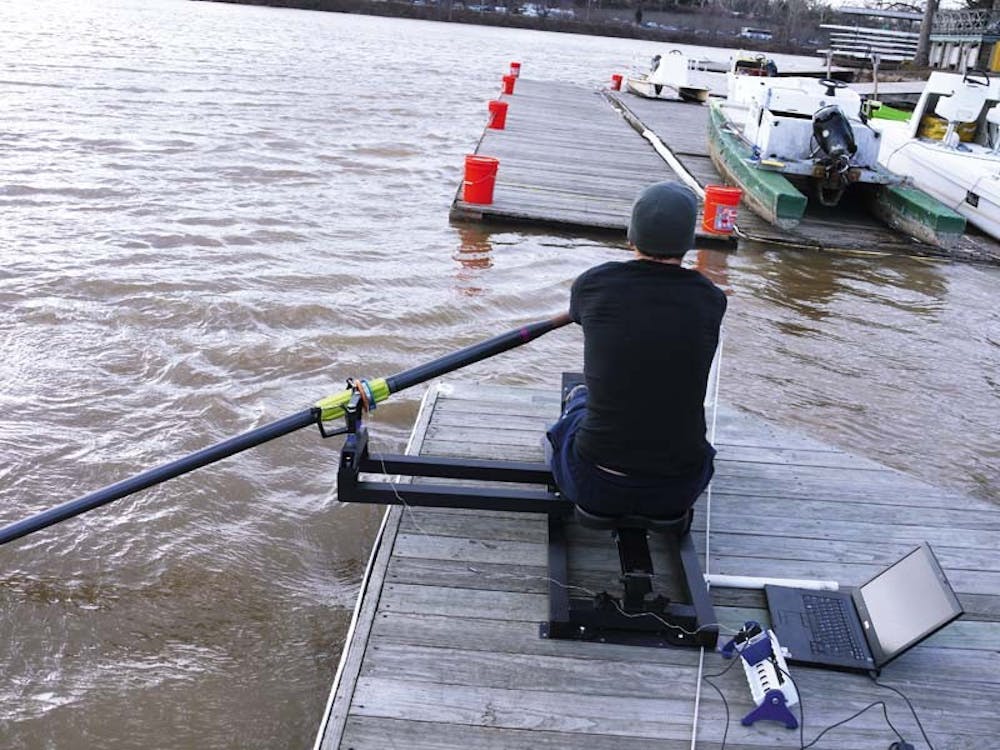
Engineering senior James Senese designed a device that would allow the rowers to control the amount of an oar in the water.
When riding up a steep hill on your bike, you shift to a lower gear to make pedaling easier. When the gear clicks into place, it becomes easier to pedal, and you make it to the top of the hill.
Engineering senior James Senese, who is studying material science and engineering and a rower on the men’s heavyweight crew team, is applying this concept to the sport of rowing for his senior design project.
Senese has chosen to build a device — which expands like a telescope — that will be able to shift the oars outward and inward so that more or less oar is in the water. The further the oars extend from the boat, the more water the rower pulls and the harder it is to row.
The device — which would replace the standard oarlock, a U-shaped device on the edge of the boat that holds the oar loosely in place — will increase or decrease the amount of oar in the water by 2.5 centimeters. Even a centimeter difference in the position of the oar is noticeable to the rower, according to Senese.
Senese’s device is a part of his capstone project, something which is required at most undergraduate engineering schools, including Penn.
“I’m on the crew team, so I wanted to do something crew-related,” he said of the inspiration for his project.
“You’re supposed to show that you can put all the things you learned in different classes together and apply them,” said material science and engineering professor Charles Graham, the instructor of the MSE senior design program.
Senese envisions that it would be controlled electronically by the coxswain, the person who steers from the front or the back of the boat. The coxswain would shift gears based on the stage of the race.
“At the start of the race, the boat isn’t moving and you would want to pick up speed quickly, so you would want to put a lighter load on it, sort of like how you would [change] your bike gears,” Senese said. “And then as you pick up speed, you would have to get more behind it, so you would have to shift to a higher gear.”
During some races, the boat must turn. Senese imagines that the coxswain could also change gears based on changes in the wind.
“[During] the Head of the Charles course in Boston, you have a full 180-degree turn. You could be going from a head wind to a tail wind [when the wind is behind the boat] which … you really feel the difference between the two,” Senese said. “So on the tail wind, you might want a heavier load, but when you are in the head wind, you might want a lighter load, so that you can keep the stroke rate up.”
Senese hopes to work with the mechanical engineering shop to build a prototype and then test it on the dock box, a device on the edge of the dock that rowers use to practice.
However, he does not think the sport would welcome electronic additions to racing boats. Currently, the only electronic in a boat is the cox box, a speaker system that allows rowers to hear the coxswain’s instructions.
“Electronics in this sport probably aren’t really welcomed, and the likelihood that if it took off that it would be allowed in racing is kind of a long shot,” Senese explained. “It could be used more as a training tool.”
The Daily Pennsylvanian is an independent, student-run newspaper. Please consider making a donation to support the coverage that shapes the University. Your generosity ensures a future of strong journalism at Penn.
DonatePlease note All comments are eligible for publication in The Daily Pennsylvanian.




